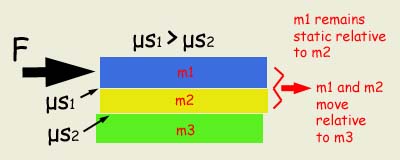Lubrication and Bearings
Friction causes heat
Friction obeys the principle of Conservation of Energy )- kinetic energy is transformed into heat energy.
For Kinetic friction, work done Wd (Joules) = F x d (Force x relative distance moved)
For Static friction, the work done is zero because there is no relative movement; d=0 therefore Wd=F x 0 = 0.
However, consider three masses, stacked on top of each other, each made of a different material. If the static co-efficient of friction (μs) between the lower two masses is less than μs between the top two then, when the force applied to the top mass overcomes the static friction between the bottom two masses, the middle and top masses will move relative to the bottom mass. The top mass will remain stationary relative to the middle mass.

Therefore there is work being done relative to the bottom mass but not the top two. It's all about choosing the right reference frame. There is always a displacement due to static friction - it may simply be due to a reactionary force. When walking, there is static friction between the sole and the ground but relative displacement, producing work, occurs between the walker and the ground, which is the reference frame that should be considered.
Reducing the cost of Friction
Friction produces heat, which is a big cause of wear and tear.
When designing mechanisms, friction should be considered and ways of minimising it should be incorporated into the design.
Lubrication
A layer of liquid or soft material between two hard objects moving against each other will reduce the amount of friction produced.
Common substances used for lubrication are oil, grease, wax and sometimes water. The molecules of these substances stick to the hard surfaces and have a low internal strength allowing them to shear (pull apart parallel to each other) easily.
Bearings
Bearings can be used to separate two materials with a high co-efficient of friction.
Plain Bearings
A material, with a relatively low co-efficient of friction, can be used to separate two moving parts made from materials that have a high co-efficient of friction. A plain bearing is normally held statically in one of the materials whilst moving relatively to the other.
Roller or Ball Bearings
A roller or ball bearing is an assembly containing balls or rollers to separate the moving parts. Balls or rollers only make contact at a point and never slide. They move easily over a surface reducing the amount of friction significantly.
Select the type of bearing
All content Copyright © Virneth Studios 2005-2011, All Rights Reserved